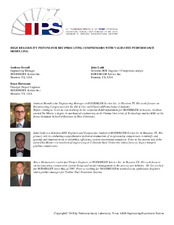| dc.contributor.other | Turbomachinery Symposium (47th : 2018) | |
| dc.creator | Ladd, John | |
| dc.creator | Hermonat, Bruce | |
| dc.creator | Brandl, Andreas | |
| dc.date.accessioned | 2019-03-12T19:48:53Z | |
| dc.date.available | 2019-03-12T19:48:53Z | |
| dc.date.issued | 2018 | |
| dc.identifier.uri | https://hdl.handle.net/1969.1/175003 | |
| dc.description | Lecture | en |
| dc.description.abstract | Piston ring leakage on reciprocating compressors is predictable due to defined leakage paths at the end gaps of piston rings. A new engineering approach quantifies the slippage and determines the dynamic pressure difference on each ring. With this approach the expected discharge gas temperature increase, expected capacity losses and the risks of rider bands activation due to piston ring slippage can be quantified. The piston design and ring styles can be iterated to find an optimized piston layout for a given application.
30% of the reciprocating compressors in the process gas industry show high sensitivity to piston ring leakage and subsequent performance related issues.
This paper suggests quantifying piston performance as a standard when evaluating compressor reliability and efficiency. The industry managed to reduce compressor valve related problems due to more sophisticated modelling tools and smart design changes on valves. It is time to go that next step on pistons. | en |
| dc.format.medium | Electronic | en |
| dc.format.mimetype | application/pdf | |
| dc.language.iso | en | |
| dc.publisher | Turbomachinery Laboratory, Texas A&M Engineering Experiment Station | |
| dc.relation.ispartof | Proceedings of the 47th Turbomachinery Symposium | en |
| dc.subject.lcsh | Turbomachines | en |
| dc.title | High Reliability Pistons for Reciprocating Compressors with Validated Performance Modelling | en |
| dc.type.genre | conference publication | en |
| dc.type.material | Text | en |
| dc.format.digitalOrigin | born digital | en |


